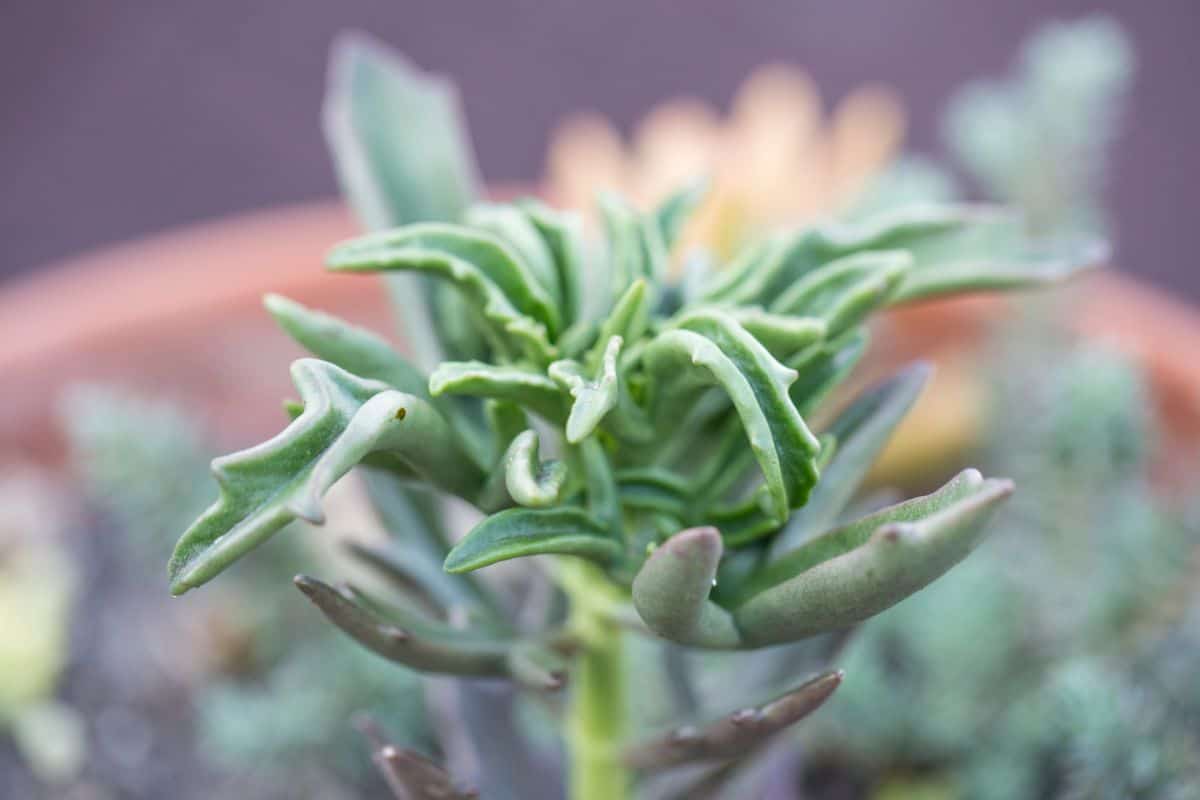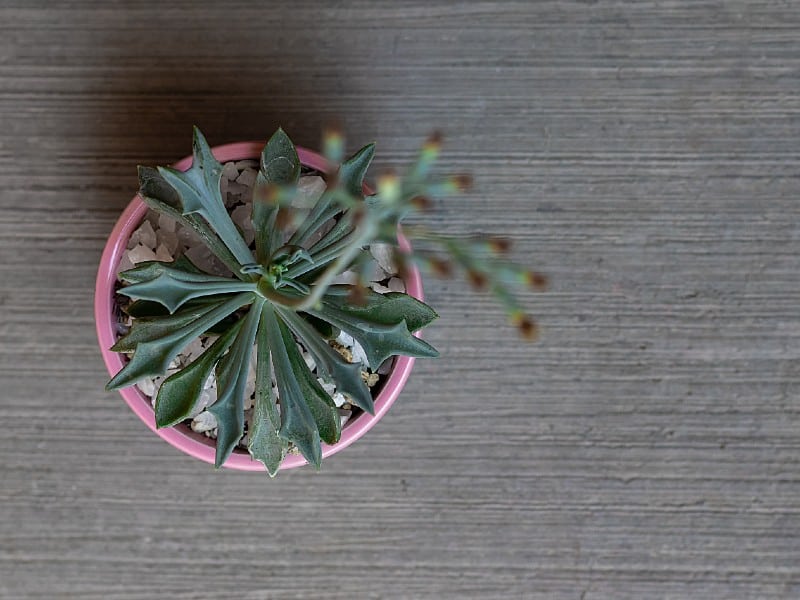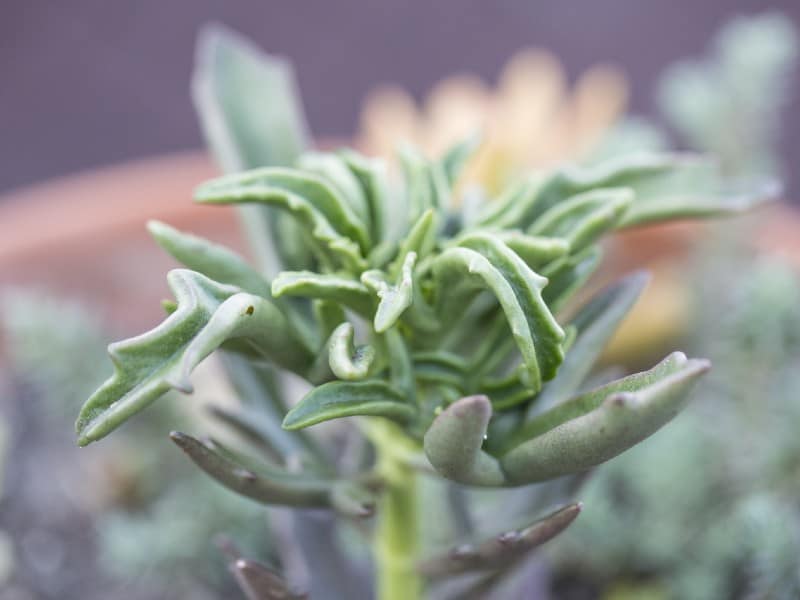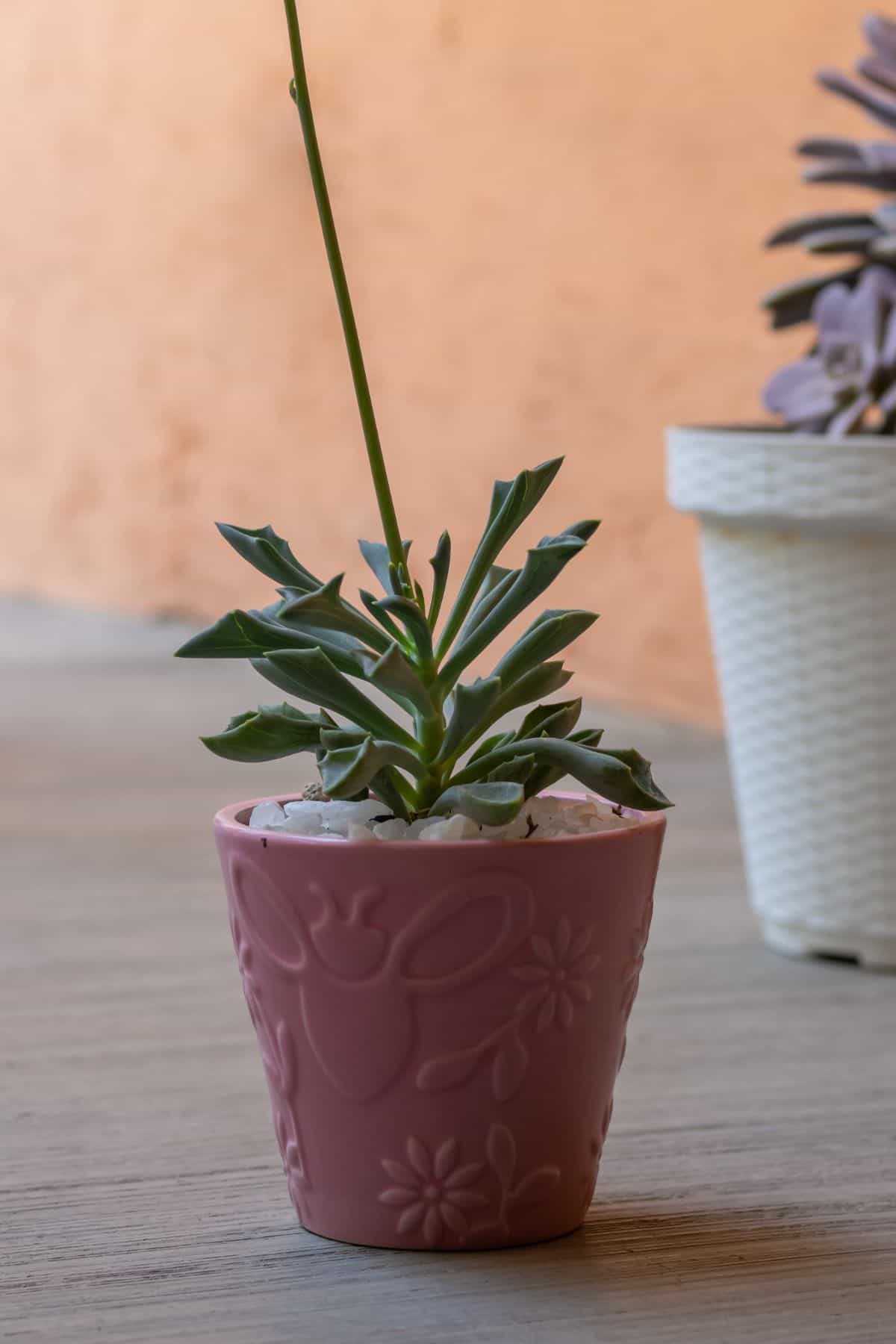Senecio kleiniiformis is a slow-growing succulent that is believed to be native to South Africa. Many botanists doubt this information is accurate, however, as the species has not yet been seen in the wild. It’s thought that this species may have been developed in cultivation.

Also known as Spear Head, Reindeer Antlers, or Spear Head Senecio, Senecio kleiniiformis is a somewhat small succulent that typically stays under 12 inches in height. Its branches are trailing and can reach up to 2 feet in length and about a half-inch in diameter.
The leaves of this unique succulent are fleshy and measure around four inches in length and about one inch in width. The blue-green leaves are long and tapering with three to five acute lobes. Some leaves may be short or spoon-shaped.
Around the end of summer or early fall, Spear Head produces pale yellow or white flowers. When grown outdoors, the blooms attract butterflies and other pollinators.
Jump to:
Senecio kleiniiformis Care
| Name: | Senecio Kleiniiformis |
| Soil: | Well-draining cactus potting mix mixed with coarse sand |
| Blooming: | End of summer or early fall |
| Light: | Partial to full sun |
| Water: | Allow soil to dry out between watering |
| Propagation: | Seeds and stem cuttings |
As with most Senecio, Spear Head is relatively easy to care for, so long as you can get their basic care right. They tend to be quite forgiving and are ideal choices for beginner and experienced gardeners alike.
It should be noted, however, that this is a slow-growing succulent, so no matter how well you care for it, you’re unlikely to see significant growth in a short period of time. If these succulents are over-fertilized, they will grow more quickly, but the growth will be leggy and unattractive.

Buy it from:
Light
When grown indoors, Senecio kleiniiformis needs bright light. In most cases, a south-facing window is ideal, but this plant will also do fine in an east or west-facing window. However, a north-facing window is unlikely to provide enough light for this succulent to thrive.
Spear Head is not a low light plant and will not be able to grow properly in environments with inadequate light levels. If your Senecio does not get enough light, it’s going to become etiolated. Etiolated plants will be stretched out with more space between the leaves. The plant may also lean toward the nearest light source.
Etiolation is in no way harmful to your succulent, but many gardeners do not appreciate the appearance of etiolated succulents. Etiolation is also permanent, so if you allow your plant to become stretched out, you will not be able to return it to its original form.
To prevent etiolation, you may need to invest in a grow light. Full-spectrum grow lights are recommended as they provide your plant with a full spectrum of light for all stages of growth. Grow lights are available in many different shapes and sizes to suit your space and succulent collection.
If you’d like to grow Senecio kleiniiformis outdoors, full sun is ideal. However, caution should be taken in areas that experience extreme heat during the summer. High temperatures can make plants more susceptible to sunburn, so you may need to provide shade during the hottest part of the afternoon.
Water
As with most Senecio, S. kleiniiformis is extremely drought tolerant. As such, it is not a plant that can tolerate overwatering. This species prefers a soak and dry method of watering.
No products found.
If you’re not familiar with this style of watering, it simply means that when the plant is ready to be watered, it’s given enough water to thoroughly soak the soil. As long as you have a container with drainage, excess water will drain from the bottom of the pot.
After the soil has absorbed as much moisture as it can, it can be allowed to dry out before watering again. During the winter, the soil can be allowed to dry out completely between watering, but it may need to be watered more frequently during the summer.
If you live in a climate that experiences high humidity, you may also need to adjust your watering schedule accordingly. Cool temperatures and high humidity mean less evaporation.
To ensure that you only water your Spear Head when it needs it, you need to check the soil moisture level before you water. You can do this using either your finger or a soil moisture meter.
Insert your moisture meter or finger into the soil near the base of your Senecio. Most soil moisture meters will need to stay in the soil for a few minutes before they give an accurate reading, but you should be able to get an instant reading using your finger.
If the soil is dry, it’s safe to water, but if the soil still feels moist, it’s best to wait a few days before trying again. Watering too soon could put your plant at risk of developing root rot.
Temperature

Senecio kleiniiformis is not a cold-tolerant plant. Though it may survive a light frost, if you expect temperatures to drop far below freezing, you’ll need to bring your succulent indoors. Many gardeners choose to keep their plants outdoors during the summer and bring them inside until temperatures warm up again.
If you’re growing Spear Head indoors, you won’t need to worry too much about seasonal temperature changes. However, it’s best to keep this plant away from doorways or windows where it may experience sudden drafts or changes in temperature.
As previously mentioned, you may also need to protect your Senecio if you live in a climate where summers are particularly hot. Though you don’t need to provide your succulents with air conditioning, you will need to keep them safe from the sun’s rays during the hottest hours of the day in order to prevent sunburn.
Soil
The best soil for S. kleiniiformis is one that allows excess moisture to drain away quickly. Ideally, your soil will be made up of large mineral particles such as coarse sand, perlite, gravel, or pumice.
These ingredients allow water to drain away quickly and reduce your plant’s chances of developing root rot. However, these materials are also inorganic and do not contain many nutrients, so you will need to add fertilizer or repot your succulent occasionally to make sure it’s getting the nutrients it needs to thrive.
It’s recommended to avoid soil mixes containing ingredients that may retain too much water. This includes soils with large amounts of clay, peat moss, or coconut coir.
If you aren’t interested in making your own soil mix, you can purchase a commercial soil formulated for cactus and succulents. This type of soil mix is made by a variety of companies, so you should find a few options at your local nursery or garden center.
Container

When choosing a container to plant your Spear Head in, be sure to choose one with adequate drainage holes. Without proper drainage, your succulent is at risk of developing root rot.
Though there are plenty of cute pots out there lacking in drainage holes, it’s best to avoid them if you’re growing succulents. Without drainage, you need to be precise in your watering schedule and this simply isn’t possible for most gardeners.
There are other methods of growing succulents in pots without drainage, such as using a cache pot, but if you’re handy with a drill you can also drill a hole or two into your existing pot. You will need to use an appropriate drill bit, however, to prevent the pot from breaking during the process.
You should also remember that terra cotta pots will absorb excess water, while glazed ceramic and plastic pots do not. This is important to remember when figuring out your succulent’s ideal watering schedule.
Propagating Senecio kleiniiformis
If you’re looking for an easy plant to propagate, Senecio kleiniiformis is the right plant for you. Regardless of the method of propagation, this process can be completed by gardeners of any skill level.
Offsets
As with most species of succulents, separating offsets is by far the easiest method of S. kleiniiformis propagation. Offsets, or pups, occasionally pop up around the base of your mature plant and can be removed easily using your bare hands.
When removing offsets, it’s often easiest to brush away the top layer of soil so you can better see the offset’s roots. Try to separate as close to the mother plant as possible to give your offset the biggest root system possible.
Gently pull the baby Spear Head from the soil using your fingers by gripping it as far down as possible. A little gentle wiggling is sometimes needed to ensure safe removal.
Once separated, you’ll need to give your offsets a few days to dry in the open air. This will allow their wounds to callous and prevent potential infection once they are reintroduced to the soil.
When your offsets are ready to plant, simply place them in the same well-draining soil you use for mature Senecio. You can then water them using the same soak and dry method you use with mature specimens.
Cuttings
Senecio kleiniiformis can also be easily propagated using stem cuttings. Just be sure to take only the healthiest sections of the stem to give yourself a higher chance of success. Unhealthy sections of plants are unlikely to survive propagation.
You’ll also want to use clean, sharp scissors or shears to collect your cuttings. The cleaner the cut, the smaller the chance of infection or other complications.
Just as you would with offsets, you’ll need to give your collected cuttings a few days to callous before they’re ready to plant. Try to keep the cuttings out of direct light during this time as it can cause them unnecessary stress.
At this point, you may also want to consider using a rooting aid, such as rooting hormone powder. This is not required for successful propagation, but many gardeners claim that it hastens the rooting process and increases their chances of success.
To use rooting hormone powder, you’ll simply need to dampen the cut end of your stem cuttings and dip them into the powder. The cuttings can then be place directly into the soil.
Again, remember to use well-draining soil. You’ll want to keep the soil moist for the first few weeks, but don’t worry about actually watering your cuttings. They won’t be able to properly absorb moisture until they develop roots.
After a few weeks, you should begin seeing tiny roots sprouting from the cut end of your Spear Head cuttings. As your cuttings grow more roots, you can begin treating them more like a mature Senecio.
Seeds
Although it is possible to grow Senecio kleiniiformis from seeds, it’s generally not the propagation method of choice for most gardeners. This is the slowest method of propagation, and it requires quite a bit of patience as it can take quite a bit of time before you have a mature Senecio on your hands.
However, if you’re committed to growing Spear Head from seeds, you’ll need to either collect seeds from your existing plants after they have bloomed and been pollinated or purchase them from a reputable seed vendor.
Once you have the seeds in your possession, you’ll need to prepare the soil. It’s recommended to start the seeds in a seed tray for several reasons. The main reason seed trays are superior is that it’s easier to control moisture levels.
Seed trays are quite shallow and dry quickly so if you accidentally over water, it’s unlikely to cause a problem. Additionally, if the soil is drying out too quickly, it’s easy to place a cover or sheet of plastic over the tray to retain moisture.
Some gardeners also recommend soaking the seeds prior to planting, but this isn’t required for successful germination.
When you’re ready to sow your seeds, simply sprinkle them over the surface of your succulent soil. You can then sprinkle a thin layer of soil over the seeds, but this step is optional.
You’ll want to keep the soil moist, but not wet, until you begin to see tiny seedlings appear. This can take several weeks, so it’s important to be patient.
Once the seedlings have sprouted, you can remove the cover and allow the soil to dry out a bit. You’ll need to wait until the seedlings are large enough to safely handle without accidental damage before you transplant them to their own containers.


